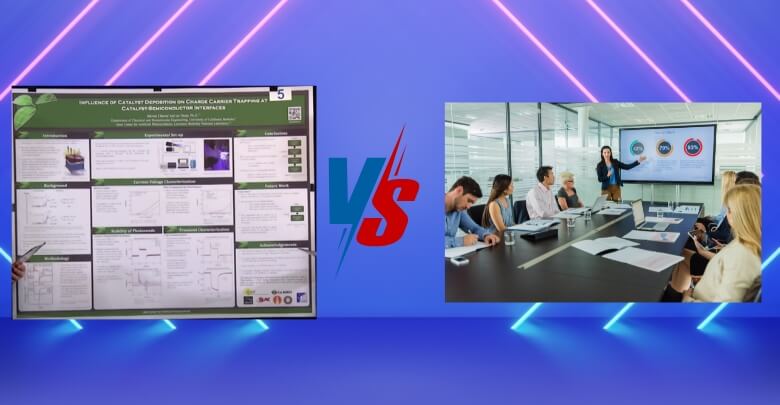Presenting at a conference is a valuable way for researchers and professionals to share their findings, discuss ideas, and connect with others in their field. Conference formats vary widely, from interactive workshops to formal presentations. But a common question many have is: Is a poster presentation better than an oral presentation?
The answer depends on your goals and audience. Poster presentations are ideal for visually engaging attendees, encouraging one-on-one interaction and feedback, and allowing for flexible pacing. On the other hand, oral presentations offer a structured approach, ideal for conveying complex ideas to a large audience at once. Both have distinct advantages based on the event’s format and your presentation style.
Curious to learn more about these presentation types? Keep reading for a detailed comparison that covers everything you need to know about choosing the right format for your research and maximizing your impact at conferences.
What is a Poster Presentation?
A poster presentation is a visual way to communicate research or ideas. It often includes a large poster that outlines the main points of the work. These presentations are popular in academic settings, as they allow for the concise sharing of information in an engaging format.

During a poster session, researchers stand by their posters to discuss their work with attendees. This format encourages direct interaction and feedback, which can improve knowledge. Participants often look for reliable conferences to join, where they can showcase their research and network with others in their field.
Effective poster presentations highlight key findings clearly and attractively. They typically feature visuals, such as charts and graphs, to support the message. This visual appeal can draw in an audience and stimulate discussion about the research topic being presented.
Is a Poster Presentation Better Than an Oral Presentation?
A poster presentation and an oral presentation both have unique advantages. Each format allows researchers to convey their work effectively, but the choice depends on various factors. Here’s a closer look at the benefits of each approach.
Visual Engagement in Poster Presentations
One major advantage of poster presentations is their visual appeal. A well-designed poster can attract attention and spark curiosity. Researchers can use images, graphs, and charts to highlight key findings. This format often encourages dialogue, allowing for a more personal connection.
Direct Interaction Opportunities
Direct interaction is another key benefit of poster presentations. Attendees can approach presenters with specific questions, leading to engaging discussions. This immediate feedback can help clarify points and foster deeper understanding. In contrast, oral presentations typically limit audience interaction, often resulting in fewer opportunities for meaningful conversations.
Flexibility in Presentation Style
A crucial component of poster presentations is flexibility. Presenters can adapt their explanations based on the audience’s knowledge level. This adaptability makes it easier to connect with diverse attendees. In an oral presentation, the format is more rigid, often limiting the presenter’s ability to tailor their message to the audience’s needs.
Time Management Considerations
There are significant differences in time management between oral and poster presentations. Poster sessions often allow for extended discussions, allowing presenters to dive deeper into their research. In oral presentations, time constraints may force speakers to rush through their material. This can leave the audience with unanswered questions or a lack of clarity about the subject matter.
Networking Potential
The two formats offer different networking opportunities. Poster presentations often occur in a more informal setting, encouraging interactions among peers. This relaxed atmosphere can facilitate connections and collaborations that might not happen during formal oral sessions. Building professional relationships is crucial in academia, and poster sessions provide a valuable platform for networking.
Audience Engagement Levels
Audience engagement levels can vary with each presentation type. Poster presentations generally allow for more one-on-one interactions, which can enhance engagement.
Attendees can explore the poster at their own pace, leading to a more personalized experience. In contrast, oral presentations may limit engagement, as the audience typically listens rather than participates actively.
Skill Development Focus
When contrasting the two formats, skill development is another factor to take into account. Poster presentations can help researchers improve their visual communication skills. Crafting a compelling poster requires careful consideration of design and clarity. Meanwhile, oral presentations focus on verbal communication, giving presenters the chance to improve their public speaking abilities.
Recognition and Rewards
When choosing a presentation format, recognition can be a major factor. Many conferences offer awards for outstanding posters, providing an incentive for researchers to participate. Additionally, presenters often receive a certificate of conference participation for poster presenters, which can improve their academic credentials and contribute to career advancement.
Both poster and oral presentations have their strengths and can suit different purposes. The decision ultimately hinges on the presenter’s goals, audience, and research context. Each format offers valuable opportunities for sharing knowledge and connecting with others.
When to Choose a Poster Presentation and When to Go for an Oral Presentation?
Choosing between a poster and an oral presentation depends on various aspects of the event and audience. Each format serves unique purposes, offering distinct opportunities to communicate research effectively. Here’s a closer look at the deciding factors.
- Event Structure: The structure of the event plays a role in presentation choice. Some conferences have more interactive settings, where poster presentations may work better, while others are more formal, suiting oral presentations.
- Audience Size: For larger audiences, an oral presentation might allow for a wider reach. Smaller, intimate events might benefit more from the individualized attention that poster presentations can offer to attendees.
- Research Complexity: More complex topics sometimes require the time and depth that an oral presentation allows. Simpler or visually rich research often aligns well with a poster’s format, engaging audiences effectively.
- Presenter’s Objective: If the goal is to spark networking, a poster presentation might foster more direct discussions. For those looking to establish authority on a topic, oral presentations may provide the right platform.
- Available Presentation Time: Shorter time slots can make poster presentations preferable, allowing visitors to absorb content quickly. On the other hand, extended time might favour a more detailed, verbal presentation approach.
- Venue Layout: A venue with dedicated poster space may lend itself to poster presentations. Auditoriums or lecture halls generally support oral presentations better due to seating arrangements and equipment setup.
- Interaction Goals: For those aiming to create a collaborative experience with audience feedback, posters may be ideal. If the intent is a structured delivery without interruption, an oral presentation may be preferable.
The choice between a poster and an oral presentation should align with the goals of the presenter, the event environment, and the expected audience engagement level. Recognizing these factors can ensure a more impactful and rewarding presentation experience.
How Poster and Oral Presentations Influence Audience Understanding?
There is a difference between an oral presentation and a poster presentation concerning how the information is absorbed and retained by the audience. Each presentation type creates unique learning experiences, catering to varied audience needs. Knowing these aspects can enhance the impact of any research presentation. Let’s explore the ways each format contributes to audience comprehension:
Multi-Sensory Engagement
A multi-sensory experience helps deepen audience knowledge. Posters combine text with visuals like charts and graphs, stimulating visual learning. Oral presentations use vocal tone, gestures, and pacing to emphasize key points. Engaging multiple senses can help reinforce messages and support different learning styles, enhancing overall retention.
Structured Flow of Information
The structure of a presentation impacts how easily the audience follows information. Posters allow viewers to explore content at their own pace, encouraging flexible learning. Oral presentations guide listeners through a predetermined flow, helping them grasp complex details. This structure ensures a smooth narrative that supports understanding and attention.
Personal Connection to Content
A personal connection with content can shape the learning experience. Posters often allow informal, direct conversations between presenters and viewers, creating a relaxed learning atmosphere. Oral presenters, with their live interaction, can connect with the audience in real time. This personal link helps attendees relate more deeply to the material presented.
Mental Load and Information Retention
Audience mental load influences how much information they can process. Posters often allow for simpler processing as viewers control their attention to details. Oral presentations can overwhelm with fast-paced content but help retain information through vocal emphasis. Balancing mental load is crucial for an effective audience experience.
Visual Reinforcement and Recall
For the audience to remember important information, visuals are essential. Posters highlight visuals to reinforce important ideas and support recall over time. Oral presentations, though less visually focused, often include gestures or slides to highlight critical points. These visual cues aid memory retention and boost comprehension.
Both poster and oral presentations offer unique advantages for enhancing audience knowledge. By tailoring each format to fit the audience’s learning preferences, presenters can maximize the effectiveness and impact of their communication, encouraging a deeper connection with their content.
Maximizing Your Impact: Tips for Both Presentation Types
Using crucial techniques that engage your audience and effectively communicate your point will help you make the most of your oral presentation or poster. Harnessing these tactics can significantly boost your presentation’s effectiveness. Consider these valuable tips across both formats for a standout presentation.
Personalize Your Content
Adjust your content to match the knowledge level and interests of your audience. This personalization ensures that your message resonates and maintains engagement. A personalized approach also highlights the benefits of conference poster presentations, as it allows for specific, audience-focused content.
Engage with Clarity
Focus on clarity to ensure your message is easily understood. Use concise language and avoid technical terms unless it’s common knowledge for your audience. Clear communication helps prevent misunderstandings and keeps your audience attentive and engaged throughout the session.
Use Visual Aids Effectively
Not only do visual aids improve poster presentations, but they also improve oral presentations. Effective use of visuals can simplify complex information and create a lasting impact. Ensure your visuals are high-quality and directly relate to the points you’re discussing.
Practice Your Delivery
For both kinds of presentations, it is crucial to practice your delivery. Pay attention to your tone and speech rate when giving oral presentations. To effectively lead viewers through your research, rehearse your speech for posters. Well-rehearsed delivery makes your presentation more polished and professional.
Gather Feedback
Actively seek feedback after your presentations. This feedback can provide insights into areas for improvement and affirm what you’re doing well. Implementing this feedback in future presentations can greatly improve your effectiveness and audience connection.
Using these strategies effectively ensures that whether you are engaging in an oral or a poster presentation, your research makes a strong, lasting impression. Optimizing your content, ensuring clarity, effectively using visuals, practicing delivery, and seeking feedback is key to maximizing your presentation’s impact.
Frequently Asked Questions (FAQs)
This FAQ section addresses common questions related to choosing between poster and oral presentations. Knowing these key points can help you make an informed decision about the best way to showcase your research. Here, you’ll find answers to some frequently asked questions about each format’s strengths and audience engagement methods.
What Are The Key Benefits Of Poster Presentations?
Poster presentations are visually engaging and allow for personalized, one-on-one interactions with viewers. This format also provides flexibility for attendees to review content at their own pace. Poster sessions create an informal setting, which can make it easier to connect with others, gather feedback, and foster networking.
How Do Oral Presentations Enhance Audience Engagement?
Oral presentations engage audiences through direct communication, making it easy to emphasize complex ideas with tone and gestures. This format allows presenters to hold the audience’s attention and guide them through the material in a structured way. Oral presentations can also reach larger audiences at once, enhancing impact.
Which Presentation Format Is More Time-Efficient?
Poster presentations generally allow attendees to explore content as they choose, making them ideal for quick, efficient interaction. Oral presentations, however, follow a set schedule, where all attendees hear the information at the same time. Each format’s time efficiency depends on the event’s structure and attendee needs.
How Can Poster Presentations Benefit New Researchers?
For new researchers, poster presentations offer a welcoming environment to share their work in a less formal setting. Presenters can discuss their ideas directly with smaller groups, gaining valuable feedback. This format also enables them to practice their communication skills, build confidence, and expand their professional network.
What Are The Ideal Venues For Each Presentation Type?
Poster presentations work best in open spaces where attendees can freely browse. Academic conferences, exhibitions, or scientific gatherings often dedicate areas for posters. Oral presentations are ideal for auditoriums or lecture halls where larger audiences can be seated comfortably, and formal communication can proceed without interruptions.
Bottom Lines
Both poster and oral presentations offer unique advantages for researchers looking to share their work. Each format has its strengths in engaging audiences and facilitating discussions. Choosing the right presentation style depends on various factors, including the event type and the presenter’s goals.
So, is a poster presentation better than an oral presentation? The answer is that it really depends on the context. Poster presentations excel in encouraging direct interaction and visual engagement, while oral presentations are effective for conveying complex ideas to larger audiences. Understanding your objectives will help you choose the best format.
As you prepare for your next presentation, remember to tailor your content for your audience, practice your delivery, and utilize effective visuals. Best of luck with your presentations, and may they inspire meaningful conversations and connections in your field!







